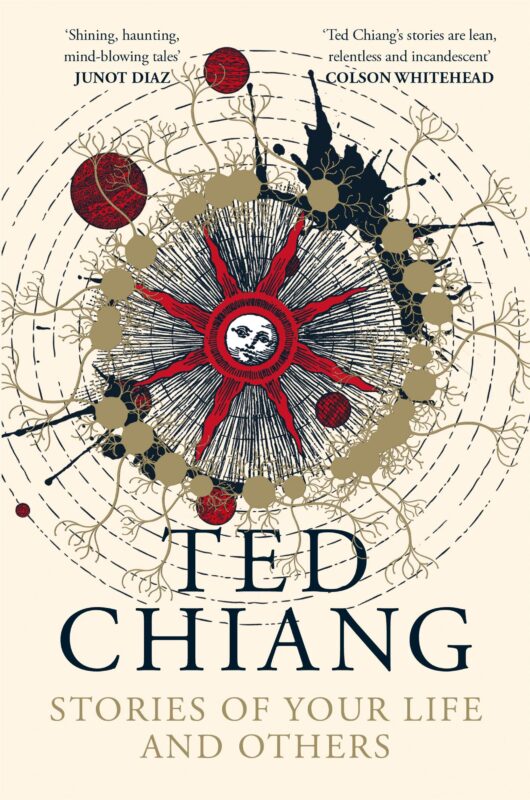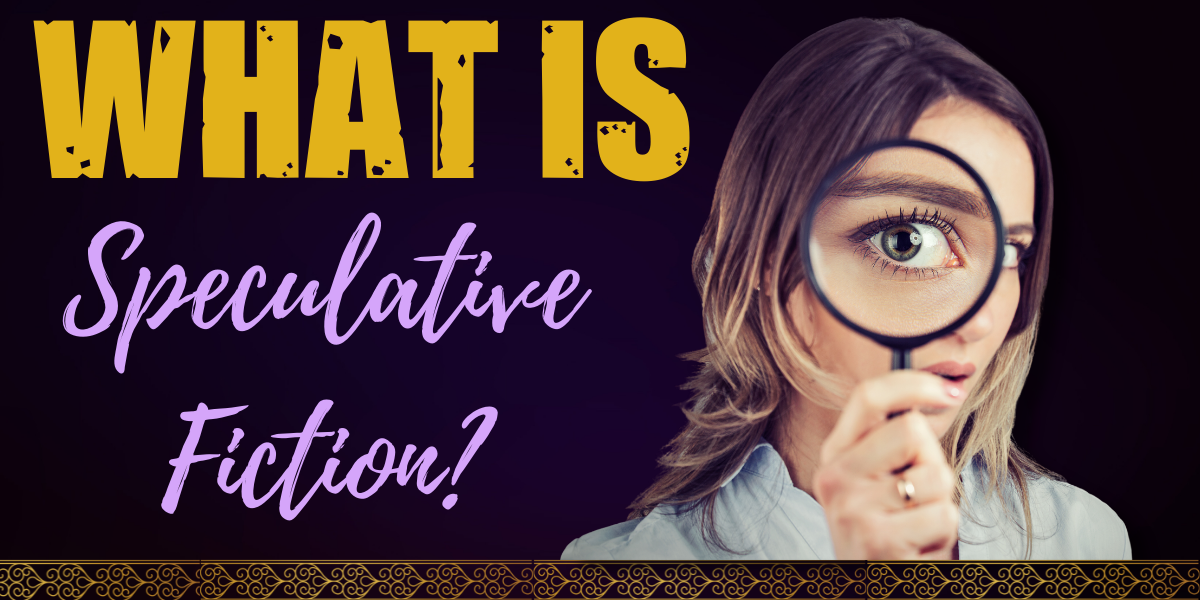Do you know the definition of speculative fiction? If not, don’t worry; you’re not alone. Up until recently, I was none the wiser, too. But curiosity ultimately got the better of me, so I did a little digging and finally figured out what this lesser-known genre is all about.
In this article, I’ll be sharing everything I’ve learned about speculative fiction so far. I’ll discuss what it is and how it’s defined, and I’ll also include some examples of famous speculative fiction works, so you can get a better idea of what it’s all about.
What is speculative fiction?
There’s a good chance that you could already be a fan of speculative fiction; you just don’t know it yet. That’s because it’s a broad, umbrella term that encompasses many different genres, including fantasy, science fiction, horror, alternative history, dystopian fiction, and apocalyptic fiction, to name a few.
Speculative fiction contains characters, themes, settings, and events that surpass what we know to be true in our own world.
Science fiction author Robert Heinlein first coined the term in the early 1940s. In the years that followed, he helped to popularise its use, mentioning it in his landmark “The Future Revisited” speech at the 1951 World Science Fiction Convention and even publishing an essay entitled “On the Writing of Speculative Fiction.”
It seems that Heinlein was trying to put an end to the debate over whether some of his works were science fiction or not. For example, his much-loved 1940 novella Magic, Inc and his subsequent up short story Waldo both contain themes of magic. This raised questions in the literary world; after all, magic belongs in fantasy novels, not science fiction, right?
But as Heinlein saw it, there were still plenty of sci-fi elements in these stories, for example, Waldo’s mechanical hand and other animatronic devices. And so, he decided that a new term was needed that encompassed both genres and more, and speculative fiction was officially born.
Also Read:- 8 Amazing Realistic Fiction Books of All-Time
Speculative fiction asks the question, “what if?”.
For example, what if you lived in a world where people were arrested for crimes before committing them, like in Philip K Dick’s Minority Report.
This what-if premise often depicts a world similar to our own, yet with one or more pivotal differences that form the basis of the story.
What’s the difference between speculative fiction, science fiction, and fantasy?
As I mentioned already, speculative fiction is a broad term that includes multiple genres, and so many sci-fi and fantasy stories fall under its umbrella.
Yet while Heinlein may have coined it to make categorizing easier, the argument between speculative fiction, science fiction, and fantasy has only intensified since those early days. Now, there’s a huge and ongoing debate in literary circles on what characterizes each genre and how the terms should be applied.
The celebrated novelists Margaret Atwood and Ursula K. le Guin famously raised the topic in a friendly debate when discussing the classifications of Atwood’s Oryx and Crake and The Year of the Flood. In Le Guin’s opinion, these novels sat firmly in the sci-fi camp, but Atwood disagreed, preferring the speculative fiction classification.
But as it turned out, this difference of opinion wasn’t because they disagreed on the elements which defined Atwood’s work. Instead, it was simply their differing ideas of what the terms ‘science fiction and ‘speculative fiction’ actually mean.
It’s also worth noting that sci-fi has suffered from bad press in the past, and some people claim the genre has less literary merit than speculative fiction. Could this perhaps explain some of Atwood’s reluctance to brand her work as science fiction in the first place?
Either way, during a later interview with the Guardian, she explained the reasoning behind her classification. In her view, science fiction “has monsters and spaceships,” and speculative fiction features elements that could potentially be a reality, if not now, in the future. She cites the example of “plots that descend from Jules Verne’s books about submarines and balloon travel and such, things that really could happen but hadn’t completely happened when the authors wrote the book.”
By this definition, her dystopian novel The Handmaid’s Tale also falls firmly into the speculative fiction category, as it features a world which in some ways is similar to our own yet has a few very unsettling differences.
Still, the debate about this broad genre rages on. It seems that there may never be a universal agreement about what exactly constitutes speculative fiction and what separates it from other similar genres. Ultimately, the decision lies with you, the reader.
Also Read:- 9 Interesting Alternate History Books – Admire the Fiction!
Examples of speculative fiction
As we’ve seen, the literary world is divided on speculative fiction, but there are still plenty of books that epitomize the genre. Here are a few famous examples.
1. 1984 by George Orwell

Pretty much all dystopian literature falls under the speculative fiction umbrella, and what better example of dystopia do we have than George Orwell’s 1984?
His chilling predictions of a totalitarian world driven by constant surveillance, distortion of the truth, and complete governmental control might not be a reality yet, but it’s a terrifying possibility of what could lie ahead.
2. Stories of Your Life and Others by Ted Chiang

This collection of eight stories by Ted Chiang is packed with what-ifs; What if the act of naming an inanimate object caused it to come to life? What if everything in the bible were entirely true, including the terrifying depictions from Revelations of sinners being swallowed up in fiery lakes of sulfur? And what if humans could construct a tower so tall that it could reach all the way up to heaven, giving us direct access to the other side?
Some of these questions ask us to imagine a scenario that, let’s face it, could never really exist in reality. But still, Chiang’s captivating world-building and authoritative prose bring these stories to life and make them seem like a genuine possibility. For this reason, they fit the speculative fiction category perfectly.
3. Early Departures by Justin A. Reynolds

Justin A. Reynold’s contemporary YA novel is a classic example of speculative fiction which also blends in elements of sci-fi, fantasy, and magical realism too. It asks what might happen if, just for a short time, you could bring your deceased best friend back to life.
Jamal’s friend Q is already dead, but thanks to brand new technology, he’s about to get a second chance at living. For a few short weeks, he’ll be temporarily reanimated before finally departing this world once and for all.
It’s the kind of advancement that human beings dream of, allowing us to reconnect with our loved ones, rewrite some of the wrongs of the past, and say all those things that were previously left unsaid. And Reynold’s intricate depiction of this futuristic technology isn’t out of the realms of possibility. Sure, it’s not going to happen any time soon, but at the current rate of progress, it could one day become a reality.
4. Frankenstein by Mary Shelley

Many readers are still caught up in the hot debate about whether Mary Shelley’s Frankenstein should be categorized as horror or sci-fi. But one thing is for sure; it’s one of the earliest examples of classic speculative fiction.
The book explores what happens when a human invention breeds unthinkable results. Two hundred years ago, when the book was first published, the idea that a scientist could create such a monster seemed utterly inconceivable. But today, advancements in science and technology make this abomination a terrifying possibility.
5. The Grace Year by Kim Liggett

Kim Liggett’s The Grace Year takes place in an unsettlingly familiar patriarchal world that pits women against each other in the most extreme of ways.
A county claims to breed girls who are utterly irresistible to any man; their skin exudes a potent aphrodisiac that contains the very essence of youth, and their hypnotic charms are said to lure men from the deepest slumber. And as a result, they drive any woman mad with envy.
But on the eve of their sixteenth year, these girls embark on their ‘grace year’ and are banished into the wild to purge their dangerous magic. Most return pure and primed for marriage, but some are never seen or heard from again. Nobody knows why because nobody talks about the grace year; it’s forbidden.
This dark mix of dystopia, horror, and fantasy is an excellent example of speculative fiction with a feminist twist.
Conclusion
Speculative fiction is a broad category that comes in many different forms and encompasses multiple different genres. As a result, it’s not always easy to define. The debates surrounding the term are showing no signs of dying down any time soon, so for now, it’s down to us to make up our own minds about what constitutes speculative fiction and what doesn’t.
What do you think? Do you have any examples of famous speculative fiction novels that I didn’t include here? Let me know in the comments below!



